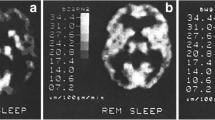Summary
In 12 patients with Huntington's disease, the relationship between brain morphology, nocturnal sleep EEG, and clinical variables was studied. Global cerebral atrophy did not significantly correlate with sleep parameters, whereas atrophy of the caudate nuclei was associated with reduced slow wave sleep and increased time spent awake. Several clinical parameters (e.g., anergia and thought disturbance scores of the Brief Psychiatric Rating Scale, illness duration and global clinical assessment) showed significant correlations with global cerebral atrophy. Similar studies in other neuropsychiatric disorders demonstrate associations between sleep alterations and brain morphological changes of different localizations, thus pointing to a complex relationship between both. It can be hypothesized that the caudate nuclei may be involved in sleep regulation; indirect evidence from studies with positron emission tomography (PET) point in the same direction.
Similar content being viewed by others
References
Bamford KA, Caine ED, Kido DK, Plassche WM, Shoulson I (1989) Clinical-pathologic correlation in Huntington's disease: a neuropsychological and computed tomography study. Neurology 39:796–801
Baxter LR, Phelps ME, Mazziotta JC, Schwartz JM, Gerner RH, Selin CE, Sumida RM (1985) Cerebral metabolic rates for glucose in mood disorders. Arch Gen Psychiatry 42:441–447
Buchsbaum MS, Gillin JC, Wu J, Hazlett E, Sicotte N, Dupont RM, Bunney WE jr (1989) Regional cerebral glucose metabolic rate in human sleep assessed by positron emission tomography. Life Sci 45:1349–1356
Buchsbaum MS, Wu, J, DeLisi LE, Holcomb H, Kessler R, Johnson J, King AC, Hazlett E, Langston K, Post RM (1986) Frontal cortex and basal ganglia metabolic rates assessed by positron emission tomography with 18F-2-deoxy-glucose in affective illness. J Affective Disord 10:137–152
Gross R, Schölmerich P, Gerok W (eds) (1987) Lehrbuch der inneren Medizin. Schattauer, Stuttgart New York
Hansotia P, Wall R, Berendes J (1985) Sleep disturbances and severity of Huntington's disease. Neurology 35:1672–1674
Ishibashi M, Nakazawa Y, Yokoyama T, Koga Y, Miyahara Y, Hayashida N, Ohse K (1987) Cerebral atrophy and slow wave sleep of abstinent chronic alcoholics. Drug Alcohol Depend 19:325–332
Kammen DP van, Kammen WB van, Peters J, Goetz K, Neylan T (1988) Decreased slow-wave sleep and enlarged lateral ventricles in schizophrenia. Neuropsychopharamcology 1:265–271
Krieg J-C, Pirke K-M, Lauer C, Backmund H (1988) Endocrine, metabolic, and cranial computed tomographic findings in anorexia nervosa. Biol Psychiatry 23:377–387
Lange HW, Aulich A (1986) Die Hirnatrophie bei der Huntingtonschen Krankheit. In: Oepen H (ed) Die Huntingtonsche Krankheit. Zur Symptomatik, Ätiologie, Früherkennung, Therapie und Selbsthilfe. Hippokrates, Stuttgart, pp 25–41
Lauer C, Schreiber W, Berger M, Pirke K-M, Holsboer F, Krieg J-C (1989) The effect of neuroendocrine secretion on brain morphology and EEG sleep in patients with eating disorders. Eur Arch Psychiatr Neurol Sci 238:208–212
Ott D, Schuhmacher M (1988) Neuroradiologische Diagnostik bei Huntingtonscher Krankheit. In: Deutschl G, Oepen G, Wolff G (eds) Die Huntingtonsche Krankheit. Klinik, Beratung, Diagnostik, Therapie. Springer, Berlin Heidelberg New York, pp 118–121
Overall JE, Gorham DR (1962) The brief psychiatric rating scale. Psychol Rep 10:799–812
Rechtschaffen A, Kales A (eds) (1968) A manual of standardized terminology, techniques and scoring system for sleep stages of human subjects. Public Health Service, US Government Printing Office, Washington DC
Schmauss C, Krieg J-C (1987) Enlargement of cerebrospinal fluid spaces in long-term benzodiazepine abusers. Psychol Med 17: 869–873
Schneider E, Ziegler B, Grau H (1982) Zur Bedeutung der Hirnatrophie für die Schlafstörungen bei hirnorganischen Erkrankungen. In: Beckmann H (ed) Biologische Psychiatrie. Thieme, Stuttgart New York
Scott DF, Heathfield KWG, Toone B, Margerison JH (1972) The EEG in Huntington's chorea: a clinical and neuropathological study. J Neurol Neurosurg Psychiatry 35:97–102
Simpson GM, Lee JH, Zoubok B, Gardos G (1979) A rating scale for tardive diskinesia. Psychopharmacology 64:171–179
Wiegand M, Backmund H, Möller A, Zulley J, Carr D, Lauer C, Krieg C (1989) Schlaf und Körperbewegungen bei Chorea Huntington. In: Fischer PA, Baas H, Enzensberger W (eds) Verhandlungen der Deutschen Gesellschaft für Neurologie, vol 5. Springer, Berlin Heidelberg New York, pp 849–852
Wiegand M, Möller AA, Lauer C-J, Stolz S, Schreiber W, Dose M, Krieg J-C. Nocturnal sleep in Huntington's disease. J Neurol (in press)
Zeumer H, Hacke W, Hartwich P (1982) A quantitative approach to measuring the cerebrospinal fluid space with CT. Neuroradiology 22:193–197
Author information
Authors and Affiliations
Rights and permissions
About this article
Cite this article
Wiegand, M., Möller, A.A., Schreiber, W. et al. Brain morphology and sleep EEG in patients with Huntington's disease. Eur Arch Psychiatry Clin Nuerosci 240, 148–152 (1991). https://doi.org/10.1007/BF02190755
Received:
Issue Date:
DOI: https://doi.org/10.1007/BF02190755




